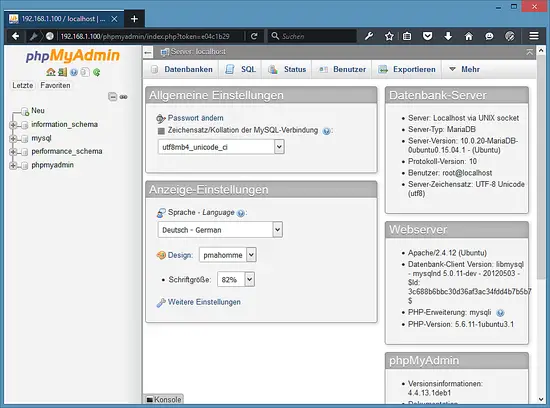Installing Phpmyadmin On Solaris 10 Network
[ad_1] INTRODUCTION This tutorial assumes you have some basic knowledge of how to use Unix and / or Linux and you have already installed and setup your Sun Solaris server. If you have not, please check my other tutorials on setting up a Sun Solaris server and come back to this tutorial. Hp Evercoss Game Java Keyped more. I will be right here waiting for you! Okay let's get started, and as always we are assuming you have installed and have pkg-get working with blastwave set as your mirror site.

MYSQL Let's take a look at the available packages to install first. # Pkg-get -a grep mysql This should output a good list of packages. Raw Image Task 1.2 Download Canon here. I am going to install mysql 5 for this tutorial. # Pkg-get install mysql5 This should install several packages that mysql depends on. So let this run for a while, it might take a while depending on your internet connection. Go ahead and select 'y' to all questions. It should finish successfully and say something like this: Installation of was successful.
Bash-3.00 # ## Executing postinstall script. Bash-3.00 # Configuring service in SMF MySQL 5 is using Service Management Facility.
If using phpMyAdmin create a file called.htaccess in the phpMyAdmin install directory and add these lines: This makes it so that phpMyAdmin can only be accessed from the localhost.
The FMRI is: svc: / network / cswmysql5: default No database directory found in the default location. If you need to build the initial database directory, see / opt / csw / mysql5 / share / mysql / quick_start-csw If you are using a non-default database directory location, please start mysql manually. Now, is not that nice. It even went ahead and created our SMF file for us so that we can use Solaris 10's SMF system.
But you will notice that it could not locate the database file. So that's what we are going to do next. We are going to use blastwave's configuration script. Run it at the location stated above: bash-3.00 # / opt / csw / mysql5 / share / mysql / quick_start-csw Then you should get some output to your terminal that looks like this: This is the blastwave quick start script to setup a MySQL5 database directory. Php Game Scripts.
The base directory is / opt / csw / mysql5. The default database directory is / opt / csw / mysql5 / var. If you have not setup a partition for the database and you want one; now is a good time to exit this script and create and mount the partition. If you have not setup a my.cnf file and you do not want one of the sample files; now is a good time to exit and create the file /opt/csw/mysql5/my.cnf. Data directory: The default is / opt / csw / mysql5 / var Follow the onscreen directions.
You can go ahead with default for everything, but you might want to select one of the sample my.cnf files. The default one uses the my-small.cnf which is for a small memory footprint server. You might want to go with one of the default configs for a server that has more memory. You should get a success response and then a message stating how to run mysql server. You are almost there!
Now just type the following at your command prompt: # Svcadm enable cswmysql5 Then check to see if everything is working fine. # Svcs grep mysql You should get an answer like this: online 0:22:05 svc: / network / cswmysql5: default If you get another state like offline or maintenance, this means you have a problem and you will need to check your mysql log files or the SMF log files to see why it's not starting. Let's try to connect to our mysql server. Now, if your path is currently something like this: / Usr / sbin: / usr / bin: / opt / csw / bin / You wont be able to just call mysql from the command line. I would recommend adding a symbolic link to the mysql executeable. # Ln -s / opt / csw / mysql5 / bin / mysql / opt / csw / bin / mysql Now let's open mysql server by typing mysql.
# Mysql It should log us right in. Type exit to exit out of mysql server. Let's now set a root password for our mysql server. Do so like this: # / Opt / csw / mysql5 / bin / mysqladmin -u root password 'new-password' Now let's check this login: Try to just type mysql at the command prompt and see what happens. You should get a denied for user root. Try again like this: # Mysql -u root -p Then when it asks for your password give it the one you set in the above command. You should be now logged in.
Now you are complete. You have a password protected mysql server and it is now running and fully functional. ADDITIONAL MYSQL SERVER SETTINGS Let's say we want to create a mysql user account to use for our websites. Let's create this user now. Login to mysql as root and run these commands use mysql; grant all privileges on *. * to ausername @ localhost identified by 'theuserspassword' with grant option; APACHE Let's take a look at the packages available. # Pkg-get -a grep apache For this tutorial we will be installing apache2 # Pkg-get install apache2 Let this run for a while and install all needed software.